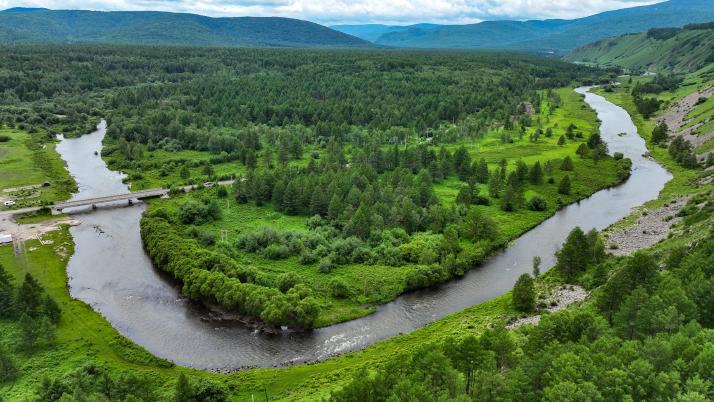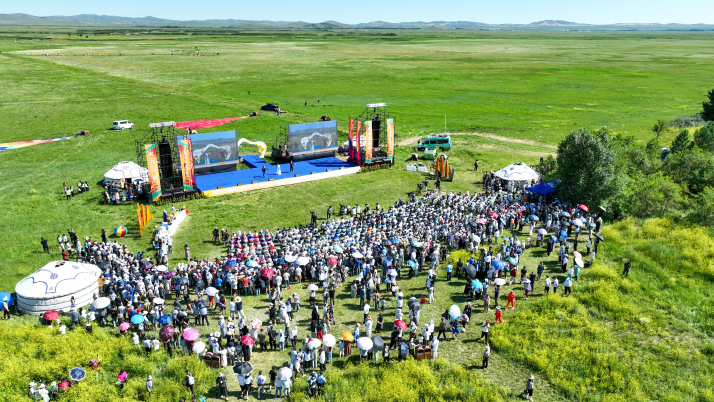| Fact Check |
| People's rights, people's gauge | |
|
|
 The Arxan National Forest Park in Hinggan League, Inner Mongolia Autonomous Region, on July 5 (XINHUA)
"Living a happy life is the primary human right." This quote from President Xi Jinping demonstrates China's people-centered approach to human rights.
China maintains that human rights should be evaluated through people's lived experience of gain, happiness and security. This holistic approach explains why environmental quality is a key indicator—leading the Central Government to prioritize ecological rights in its landmark Fourth Human Rights Action Plan (2021-25) released in September 2021. On August 4, the author joined the weeklong Human Rights Action in China—2025 Inner Mongolia Tour. Think tank scholars and journalists from Germany, Italy, the Netherlands, France, Greece, Spain, Hungary and China visited Xilingol League and Hinggan League in Inner Mongolia Autonomous Region to observe local ecological protection and development efforts—a concrete example of China's commitment to the principle that "lucid waters and lush mountains are invaluable assets," meaning "green is gold."  Tourists enjoy a grassland performance in Xilingol League, Inner Mongolia, on July 13 (XINHUA)
Ecological shield Just a 1.5-hour flight from Beijing, Xilingol League stretches across the vast grasslands of Inner Mongolia, serving as a vital ecological security barrier for China's northern border regions. Its capital, Xilinhot, is celebrated as the Pearl of the Grasslands. A 600-km journey eastward from Xilinhot, passing through the Ulagai Management Area to Arxan City in Hinggan League, transports travelers from sweeping grasslands to dense forests, with greenery and fresh air throughout the scenic route. The Ulagai Management Area is one of China's major natural grasslands, boasting a diverse variety of wild plants—with over 850 species discovered to date. It is an innovative scenic spot based on pristine grasslands and natural landscapes, which focuses on the protection of meadow grassland and wetland ecosystems and biodiversity, and integrates resource conservation, science popularization and education, and eco-tourism. Altogether, this approach sets an example for the country, and even the world at large, in balancing ecological protection and economic development. Inner Mongolia's ecosystem is both nature's gift and humanity's achievement. Take Hatubuqi, a flourishing village in Hinggan League, for example. Its lush vegetation now brings smiles to local herders and farmers—a stark contrast to its past of severe desertification. In earlier years, spring meant choking yellow sands that blotted out the sun. Sandstorms ravaged crops, contaminated water sources and left cattle starving, plunging the community into hardship. Today's transformation stands as living proof of ecological restoration's power. Since 2017, the central authorities have provided targeted assistance to Hatubuqi, helping stabilize sandy lands by planting and nurturing approximately 1,000 hectares of sea buckthorn forests across two wind-prone areas. The sea buckthorn's deep roots bind loose soil, preventing desert expansion. Moreover, the forests reduce wind velocity, protecting nearby farmland and homes from erosion. In June 2023, Hinggan League launched a campaign to combat desertification, with one third of the league's sandy lands having been effectively treated. The local sandy land area has decreased from approximately 335,000 hectares in 2020 to 218,000 hectares today. Increasing local incomes The Shoufang Xilingol Cheese Culture Industrial Park, a major traditional cheese producer in Xilingol, produces 21 types of specialty cheese. People living on these grasslands have had the tradition of making cheese since ancient times. This traditional method mainly relies on heating and fermentation, with a production time longer than that of modern cheese-making methods and resulting in higher quality. At present, the park has four production workshops, altogether boasting an annual output value of nearly 100 million yuan ($14 million). The cheese produced at the industrial park mainly comes from the milk produced by dairy cows raised by local herders on the vast Xilingol Grassland, which is of a better quality than the milk produced by pen-raised cows. The industrial park has an annual production capacity of 15,000 tons of dairy products. With 7 kg of fresh milk producing 1 kg of cheese, the park needs to purchase more than 100,000 tons of fresh milk from herders each year, offering them a steady channel to sell and ensuring stable incomes. More than a cheese industrial park, it has also become a tourist attraction centered on cheese culture. With its "industrial park + cultural tourism + local dairy products" model and related events, including cheese tasting sessions and cheese culture festivals, it attracts 50,000 visitors on average every year, boosting local tourism and the night economy. The night economy refers to economic activities and consumption that occur primarily during evening and nighttime hours. Powered by the industrial park, Xilingol League has managed to establish several standardized cheese workshops, providing local farmers and herders with business startup opportunities and improving the league's economic vitality. At 7 a.m. on August 7, the revamped Arxan Express tourist train embarked on its inaugural journey. Featuring five themed carriages, the train offers immersive theater performances and intangible cultural heritage activities. This is a new initiative in Arxan's "ecology + culture and tourism" strategy. Based on its abundant green tourism resources, Arxan is actively embracing the "green is gold" concept, attracting a diverse range of tourists, from those seeking wellness treatments to students. In Arxan's forests, pinecones are more than winter bird food or windborne seeds—they become art. At the Mengxiaosong Forest Culture and Art Museum, these natural treasures are transformed into exquisite handicrafts, embodying the creativity of Arxan's people. The museum has pioneered a "tourism + study tour" model, offering immersive forest culture classes where visitors work with pinecones and pine needles. These humble cones now symbolize a profound truth: As Arxan's ecology has flourished, so have its communities. What was once nature's bounty has become both cultural heritage and economic lifeline—proof that environmental restoration and human prosperity can grow from the same root. Inner Mongolia, based on its favorable ecological environment, has managed to develop distinctive industries tailored to its local conditions, promoting regional development and providing locals with more job opportunities and business startup platforms. By participating in tourism services and joining livestock cooperatives, farmers and herders have increased their incomes and improved their quality of life, creating a material basis for safeguarding people's basic rights, which include those to work, health and education, among others. This model, increasing incomes through industrial growth while advancing human rights through development, creates a powerful synergy between economic progress and rights protection. By fostering social equity, ecological conservation and community wellbeing, it establishes the essential conditions for fulfilling humanity's most fundamental right: the pursuit of happiness. Copyedited by Elsbeth van Paridon Comments to lanxinzhen@cicgamericas.com |
|
||||||||||||||||||||||||||||||
|